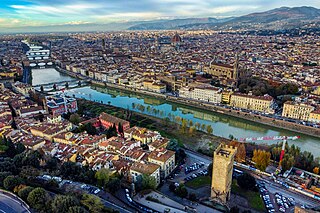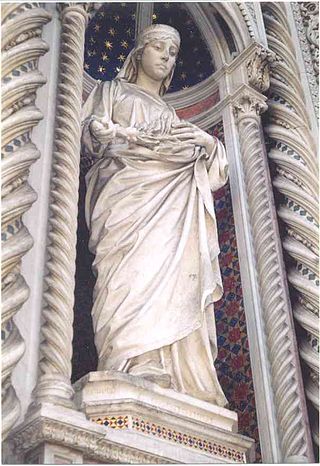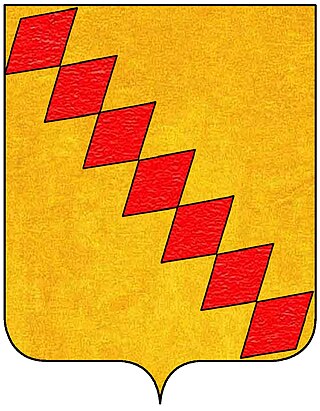
Dante Alighieri, most likely baptized Durante di Alighiero degli Alighieri and widely known and often referred to in English mononymously as Dante was an Italian poet, writer, and philosopher. His Divine Comedy, originally called Comedìa and later christened Divina by Giovanni Boccaccio, is widely considered one of the most important poems of the Middle Ages and the greatest literary work in the Italian language.

Florence is the capital city of the Italian region of Tuscany. It is also the most populated city in Tuscany, with 360,930 inhabitants in 2023, and 984,991 in its metropolitan area.

Pistoia is a city and comune in the Italian region of Tuscany, the capital of a province of the same name, located about 30 kilometres (19 mi) west and north of Florence and is crossed by the Ombrone Pistoiese, a tributary of the River Arno. It is a typical Italian medieval city, and it attracts many tourists, especially in the summer. The city is famous throughout Europe for its plant nurseries.

San Gimignano is a small walled medieval hill town in the province of Siena, Tuscany, north-central Italy. Known as the Town of Fine Towers, San Gimignano is famous for its medieval architecture, unique in the preservation of about a dozen of its tower houses, which, with its hilltop setting and encircling walls, form "an unforgettable skyline". Within the walls, the well-preserved buildings include notable examples of both Romanesque and Gothic architecture, with outstanding examples of secular buildings as well as churches. The Palazzo Comunale, the Collegiate Church and Church of Sant' Agostino contain frescos, including cycles dating from the 14th and 15th centuries. The "Historic Centre of San Gimignano" is a UNESCO World Heritage Site. The town also is known for saffron, the dry aged and saffron infused Golden Ham, pecorino cheese and its white wine, Vernaccia di San Gimignano, produced from the ancient variety of Vernaccia grape grown on the sandstone hillsides of the area.

The Chiesa di Santa Margherita de' Cerchi is a 13th-century, Roman Catholic church dedicated to Margaret the Virgin in the centre of Florence, region of Tuscany, Italy. It is among the oldest churches in Florence.

The Battle of Campaldino was fought between the Guelphs and Ghibellines on 11 June 1289. Mixed bands of pro-papal Guelf forces of Florence and allies, Pistoia, Lucca, Siena, and Prato, all loosely commanded by the paid condottiero Amerigo di Narbona with his own professional following, met a Ghibelline force from Arezzo including the perhaps reluctant bishop, Guglielmino degli Ubertini, in the plain of Campaldino, which leads from Pratovecchio to Poppi, part of the Tuscan countryside along the upper Arno called the Casentino. One of the combatants on the Guelph side was Dante Alighieri, twenty-four years old at the time.

Campo Marzio is the 4th rione of Rome, Italy, identified by the initials R. IV. It belongs to the Municipio I and covers a smaller section of the area of the ancient Campus Martius. The logo of this rione is a silver crescent on a blue background.

Florence weathered the decline of the Western Roman Empire to emerge as a financial hub of Europe, home to several banks including that of the politically powerful Medici family. The city's wealth supported the development of art during the Italian Renaissance, and tourism attracted by its rich history continues today.

The House of Bardi was an influential Florentine family that started the powerful banking company Compagnia dei Bardi. In the 14th century the Bardis lent Edward III of England 900,000 gold florins, a debt which he failed to repay along with 600,000 florins borrowed from the Peruzzi family, leading to the collapse of both families' banks. During the 15th century the Bardi family continued to operate in various European centres, playing a notable role in financing some of the early voyages of discovery to America including those by Christopher Columbus and John Cabot.

The Simonetti family is an Italian noble family with origins in Tuscany. During the 12th century different branches in Florence, Terni, Lucca, Pistoia and Pescia developed. Other famous branches of this family were established in Jesi, Palermo, Milan and Bologna.

Corso Donati was a politician and leader of the Black Guelph faction in 13th- and early 14th- century Florence.
Piccarda Donati was a medieval noblewoman and a religious woman from Florence, Italy. She appears as a character in Dante Alighieri's Divine Comedy.
Forese Donati was an Italian nobleman born in Florence, associated with the Guelphs. He was the son of Simone di Forese and Tessa, and the brother of Corso and Piccarda Donati. He was married to Nella Donati, and had one daughter, Ghita, with her. He was known as a childhood friend of Dante Alighieri. He died in 1296, in Firenze.

The Arte di Calimala, the guild of the cloth finishers and merchants in foreign cloth, was one of the greater guilds of Florence, the Arti Maggiori, who arrogated to themselves the civic power of the Republic of Florence during the Late Middle Ages. The ascendancy of the Calimala ran from the organization of Florentine guilds, each with its gonfaloniere in the thirteenth century, until the rise of the Medici usurped all other communal powers in the fifteenth century. Their presence is commemorated in the via di Calimala, leading away from the city's Roman forum through the Mercato Nuovo to the former city gate, the Por Santa Maria, as the Roman cardo; the main street, as old as Florence itself, was a prime location for trade, even though, unpaved, crowded, and much narrower than its present state, it was truly a callis malis, an "ill passage-way". The name Calimala is of great antiquity and obscure etymology. Though the original earliest archives of the Arte di Calimala were lost in an 18th-century fire, abundant copies, preserved at the Archivio di Stato, Florence, document the guild's statutes and its activities.

Pier Saccone Tarlati di Pietramala (1261–1356) was an Italian condottiero from Pietramala d'Arezzo in the Val d'Arno, a rocca that controlled the mule track between his native town of Arezzo and Anghiari. Pietramala was the seat of the powerful family of the Tarlati, who came to prominence in the strife following Arezzo's decisive defeat at Campaldino (1289) as heads of the Ghibelline "Secchi" faction of Arezzo. Pier Saccone's brother was Guido Tarlati, bishop and signore of Arezzo.

The Palazzo Comunale, also known as the Palazzo del Popolo of San Gimignano has been the seat of the civic authority in the comune since the 13th century. It is located on the Piazza del Duomo close to the Collegiate Church of the Assumption of the Blessed Virgin Mary. The building and Collegiate Church are at the heart of the medieval town, and are part of the UNESCO World Heritage Site of the "Historic Centre of San Gimignano".

Folco Portinari was an Italian banker and several times the prior of Florence. He was the father of Beatrice Portinari, the woman largely identified as the character loved by Dante Alighieri and mentioned in his works.

Piazza dei Signori is a city square in Verona, Italy.

The Fioravanti family was a noble family originating in Pistoia in Tuscany and active in Florence and other Italian towns. They were Guelf in their politics and naturally allied with the Cancellieri family and adversaries of the Ghibelline Panciatichi Panciatichi family. An early record dates to 1267, when Fioravanti d'Accorso was a member of the town council. In 1310 Ranieri, his son, was Mayor of the Pistoia. In 1319 Simone di Ranieri was a member of the elders. Giovanni di Puccio di Ranieri Fioravanti was a banker active at the court of Pope Clement V (1305-1314) in Avignon. Andrea di Simone di Baldo Fioravanti was elected Capitano della Montagna Superiore, June 17, 1354. Francesco di Rinieri was the Gonfaloniere of the Florentine Republic in the years 1385 and 1389: Neri his son was also Gonfaloniere in 1428; Fioravanti di Piero was the Cavalry Captain in Flanders in 1510 and then for Pope Alessandro VI, commissioner at Assedius of Faenza: Vincenzo di Cipriano one of the first to be elected knight of Santo Stefano, in 1576, shortly after the establishment of that military order, and later Chancellor of the Order: Fabio of Cipriano, was Cavalry Captain in the Netherlands: Alberto di Fioravanti Knight of Malta in 1590, and Commendatore in 1610: Niccolao di Fioravanti captain in the emperor Ferdinand II against the King of Sweden in 1636, and in 1643 in Tuscany for the Grand Duke against the Barberini.



















